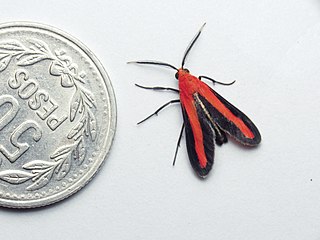
Edward Meyrick was an English schoolmaster and amateur entomologist. He was an expert on microlepidoptera and some consider him one of the founders of modern microlepidoptera systematics.
Sir George Francis Hampson, 10th Baronet was an English entomologist.

Nepticulidae is a family of very small moths with a worldwide distribution. They are characterised by eyecaps over the eyes. These pigmy moths or midget moths, as they are commonly known, include the smallest of all living moths, with a wingspan that can be as little as 3 mm in the case of the European pigmy sorrel moth, but more usually 3.5–10 mm. The wings of adult moths are narrow and lanceolate, sometimes with metallic markings, and with the venation very simplified compared to most other moths.

Eupterotidae is a family of insects in the order Lepidoptera with more than 300 described species.

Urodidae or "false burnet moths" is a family of moths in the lepidopteran order. It is the type genus in the superfamily, Urodoidea, with three genera, one of which, Wockia, occurs in Europe.
Agathiphaga is a genus of moths, known as kauri moths. It is the only living in the family Agathiphagidae. This caddisfly-like lineage of primitive moths was first reported by Lionel Jack Dumbleton in 1952, as a new genus of Micropterigidae.
Herbert Druce, FLS was an English entomologist. His collections were acquired by Frederick DuCane Godman (1834–1919), Osbert Salvin (1835–1898), and James John Joicey (1870–1932) before being bequeathed to the Natural History Museum, London. He is not to be confused with his son, the English entomologist Hamilton Herbert Druce, who also worked on Lepidoptera.

Sematurinae is a subfamily of moths in the family Sematuridae represented by at least 29 species in the Neotropics.

Ctenucha is a genus of moths in the family Erebidae.
Haemanota is a genus of moths in the family Erebidae. The genus was erected by George Hampson in 1901.

George Talbot FES was an English entomologist who specialised in butterflies. He wrote about 150 scientific papers, the majority being primarily systematic, consisting of the description of new species or the revision of various genera. He was also responsible for the curation and preservation of the Joicey collection of Lepidoptera prior to its accession by the Natural History Museum.

The Thyatirinae, or false owlet moths, are a subfamily of the moth family Drepanidae with about 200 species described. Until recently, most classifications treated this group as a separate family called Thyatiridae.

Neuroxena is a genus of tiger moths in the family Erebidae. The genus was described by William Forsell Kirby in 1896.

Tipulodes is a genus of moths in the subfamily Arctiinae, which currently contains 3 species. The genus was described by Boisduval in 1832. The genus is described as "Small Arctiids with relatively narrow wings. Ground colour brownish black with characteristic wings patterns. Forewing with elongate rusty-red blotch from the base almost to the apex, hindwing with rusty-red stripe along the costal edge; underside of wings similarly coloured. Males with coremata forming membranous tubes, much longer than abdomen when everted, covered with hairs along the whole length"
Celonoptera is a monotypic moth genus in the family Geometridae. Its only species, Celonoptera mirificaria, is found in south-eastern Europe. Both the genus and species were first described by Julius Lederer in 1862.
Haemanota rubriceps is a moth of the family Erebidae. It was described by George Hampson in 1901. It is found in Brazil.
Neuroxena rubriceps is a moth of the subfamily Arctiinae. It is found in Madagascar.
Tipulodes ima is a moth in the subfamily Arctiinae. It was described by Jean Baptiste Boisduval in 1832. It is found in the Brazilian states of Espírito Santo, Rio Grande do Sul and Rio de Janeiro, and in Paraguay and Argentina.










